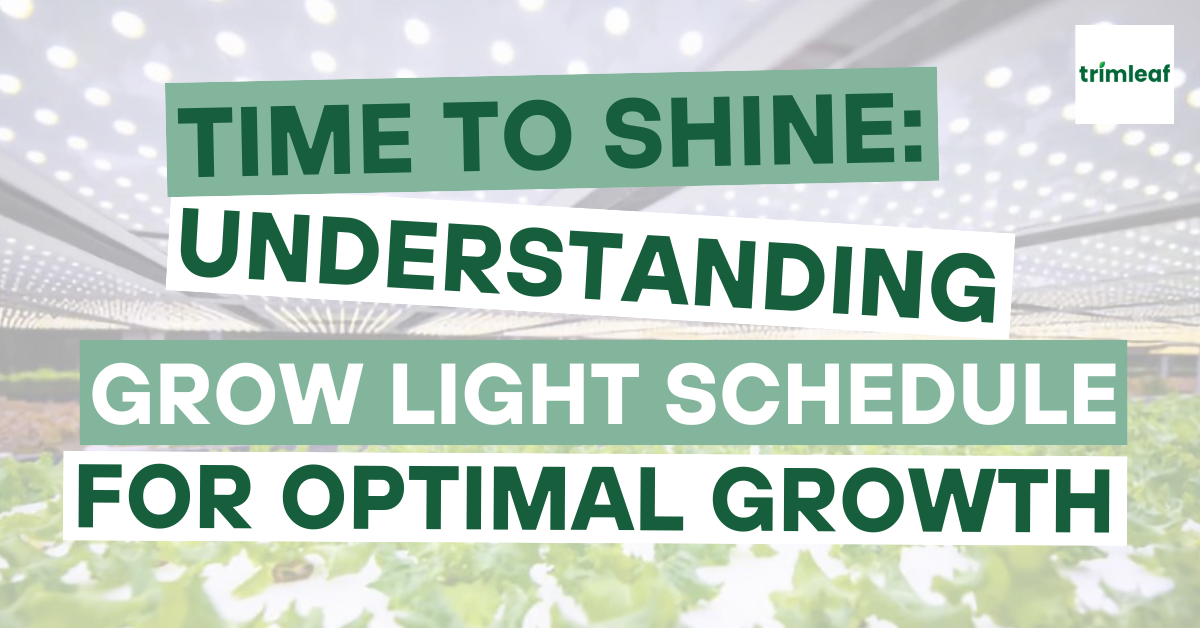
Indoor gardening has become increasingly popular, thanks to the convenience and versatility of grow lights.
Whether you’re growing herbs, vegetables, or ornamental plants, these lights make it possible to garden year-round, even if you're limited by outdoor space or seasonal changes.
While grow lights open up exciting possibilities for indoor gardening, simply owning them isn’t enough. The key to successful plant growth lies in understanding how long your grow lights should be on.
Light duration is as critical as the distance and intensity of your fixtures, directly impacting photosynthesis, plant development, and yield. Too little light can stunt growth, while too much can stress plants and waste energy.
If you're unsure about how to manage your grow light schedule, this guide will walk you through designing the perfect lighting program for your indoor garden.
Table of Contents
Understanding How Plants Use Light

Just like outdoor plants rely on sunlight, indoor plants depend on grow lights for energy and development. These lights simulate natural sunlight cycles, supplying the energy plants need to thrive.
One of the most critical aspects of plant care is establishing a light cycle that aligns with the plants' biological processes. Plants have evolved to grow under consistent day-night rhythms, and mimicking these cycles with grow lights ensures they receive the right balance of energy and rest. This promotes healthy growth and photosynthesis.
Photosynthesis and Light Cycles

Photosynthesis is how plants convert light into energy. When plants absorb light through their leaves, they convert carbon dioxide and water into glucose, fueling their growth. Without enough light, photosynthesis slows, resulting in poor growth, yellowing leaves, and even death.
Different plants have specific light needs to trigger photosynthesis. Some require long exposure to thrive, while others need less. Light cycles also play a key role in triggering growth stages like flowering and fruiting. This makes it essential to tailor your light schedule to the specific plants you're growing.
How Long Should Your Grow Lights Be On?
Light duration is one of the most important factors in indoor gardening. Whether you’re growing herbs, vegetables, or flowers, providing the right amount of light is key to healthy development.
As a rule of thumb, most plants require 12 to 16 hours of light per day, with rest periods being equally essential. While it may seem logical to provide continuous light, overexposure can stress plants. Rest periods allow plants to recover and metabolize nutrients.
Remember, too much light can cause leaf burn, while too little can lead to leggy, weak plants.
Light Requirements for Different Growth Stages
Plants, especially those that bear fruit or flowers, have changing light needs at different growth stages. Adjusting light duration accordingly can significantly boost growth.
- Seedling Stage: Young plants need the most light, around 18–20 hours per day, to establish strong roots and early growth.
- Vegetative Stage: Plants focus on developing leaves and stems during this phase and generally need 16–18 hours of light per day.
- Flowering and Fruiting Stage: A reduction in light to around 12–14 hours per day helps plants focus energy on producing flowers or fruits, imitating the shorter days of fall.
Specific Light Durations for Different Plant Types
Some plants thrive under specific lighting schedules:
- Herbs and Leafy Greens: Require 14–18 hours of light for optimal growth.
- Fruiting Plants: Need 16–18 hours during the vegetative stage, with 12–14 hours during the flowering phase.
- Cannabis: Requires 18 hours of light in the vegetative stage, reduced to 12 hours when buds develop.
Best Practices for Managing Grow Light Schedules
Effectively managing to grow light schedules is key to promoting plant health. By using the following best practices, you can ensure that your plants receive the consistent light exposure they need.
Using Timers or Controllers for Consistency

Automation is one of the best ways to ensure that your plants get consistent light. Many LED grow lights have built-in timers, or are compatible with external controllers, allowing you to easily set specific durations and even adjust brightness levels.
Benefits of Using Timers or Controllers
- Consistency: Timers remove the variability of manual operation, ensuring plants get the right light daily.
- Healthy Growth: Consistent exposure supports stable growth, leading to healthier plants.
- Less Stress: Timers prevent abrupt shifts in brightness, reducing stress for plants.
Avoiding Common Mistakes with Light Schedules
Be mindful of these common mistakes:
- Too Much or Too Little Light: Overexposure can cause leaf burn, while too little can make plants leggy and weak.
- Inconsistent Schedules: Inconsistent lighting can disrupt a plant’s natural rhythm, leading to poor growth. Stick to a regular schedule to avoid these issues.
Conclusion
Proper light duration is essential for healthy plant growth. By understanding specific light needs at different growth stages, you can create an optimal environment that fosters robust development and maximizes yields.
Best practices, such as using timers and controllers, help ensure consistent and precise light exposure. Mastering the light schedule is a continuing process. Considering the allowances in time, don’t hesitate to experiment with different light exposures to help you optimize plant growth.
Ready to elevate your indoor garden? Explore our selection of grow lights and controllers to start achieving remarkable growth results.
Want to learn more about LED grow lights? Read more here:
- Growing Indoors with LED Grow Lights? Here are 4 Things to Consider
- The Best 4x4 LED Grow Lights
- How Does the Grow Light Spectrum Influence Cannabis Growth?
- Best LED Grow Lights (2024)
- Grow Lights: How Many Watts Per Plant/Square Foot is Needed?
- LED Grow Lights and Eye Safety: What You Need to Know
- Pay Attention to These Things When Buying LED Grow Lights
Frequently Asked Questions About Grow Light Schedule
- What is the primary function of grow lights in indoor gardening?
- Grow lights simulate natural sunlight, providing the necessary light spectrum for plant growth and development.
- How do grow lights differ from traditional indoor lighting?
- Grow lights are specifically designed to emit wavelengths of light that are beneficial for plant photosynthesis, while traditional lighting may not provide the optimal spectrum.
- Why is light duration crucial for indoor plant growth?
- Light duration directly affects photosynthesis, which is the process by which plants convert light into energy for growth.
- What can happen if plants receive too little light?
- Plants may experience stunted growth, yellowing leaves, and reduced yields if they don't receive enough light.
- What are the potential consequences of providing plants with too much light?
- Overexposure to light can lead to leaf burn, stress, and reduced plant health.
- What is photosynthesis, and why is it important for plants?
- Photosynthesis is the process by which plants convert light energy into chemical energy (glucose) for growth and development.
- How does the light spectrum affect photosynthesis?
- Different wavelengths of light are absorbed at varying rates by plants. Red and blue light are particularly important for photosynthesis.
- Why are consistent light cycles essential for plant growth?
- Plants have evolved to follow natural day-night cycles, which regulate their growth and development.
- How can light cycles be used to trigger specific growth stages in plants?
- By manipulating the duration of light exposure, you can influence flowering, fruiting, and other growth stages.
- Do different plant species have varying light requirements?
- Yes, different plants have unique light needs based on their native environments and growth characteristics.




